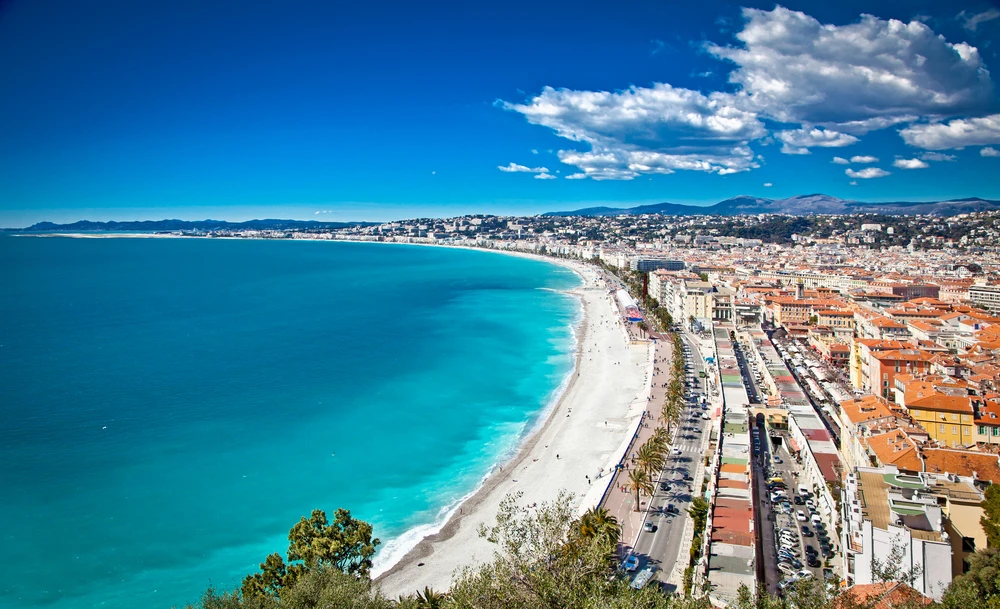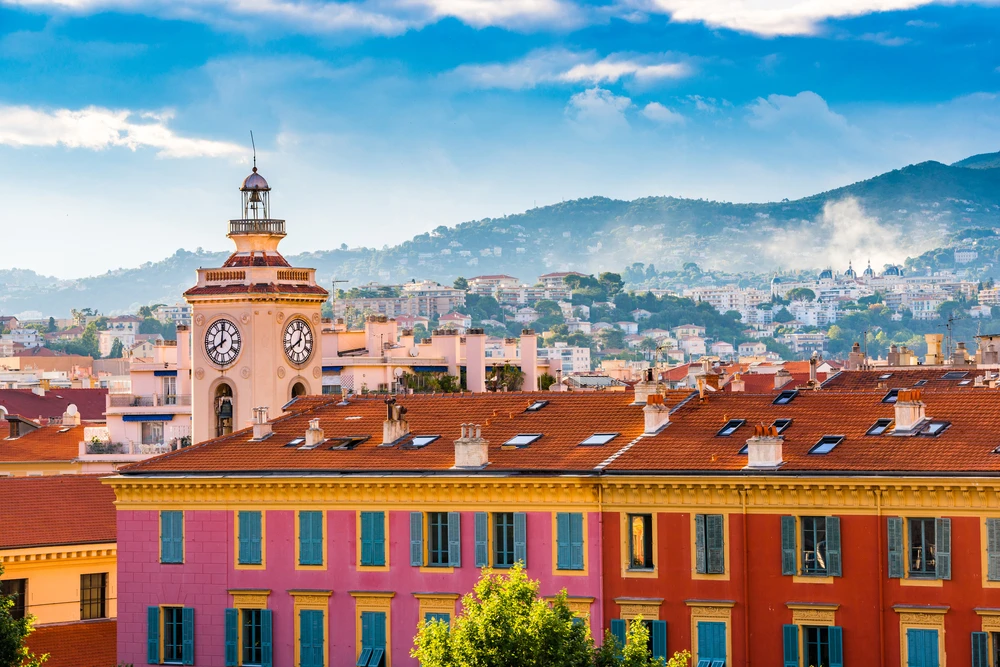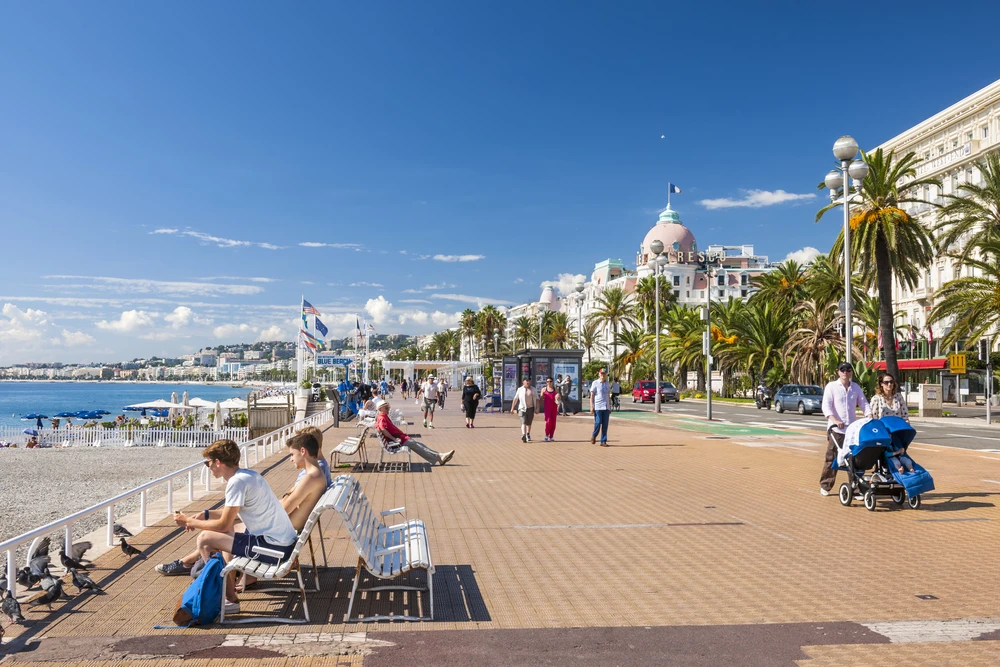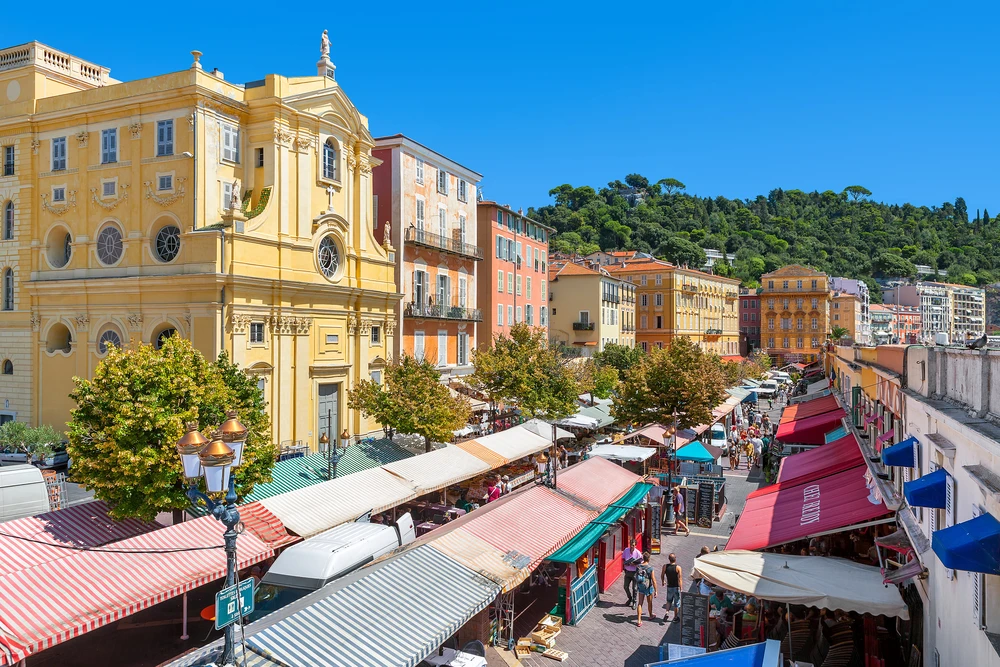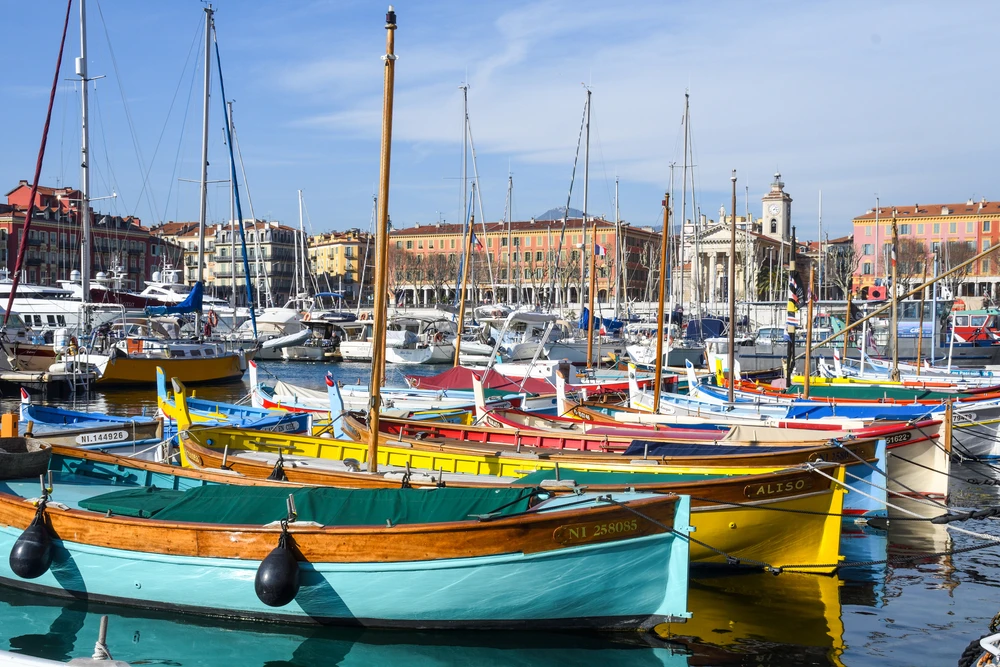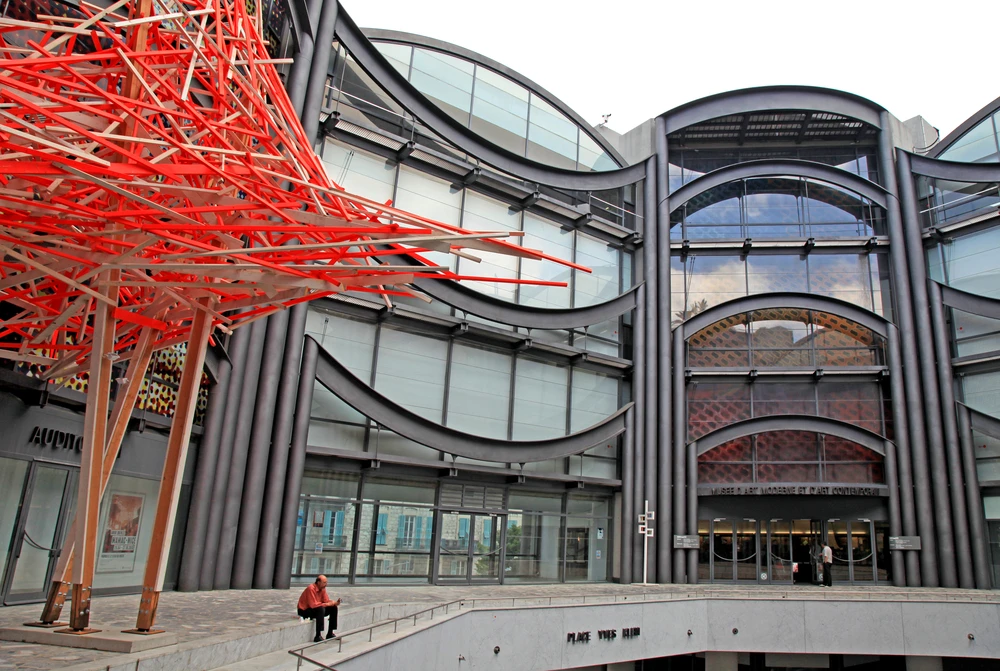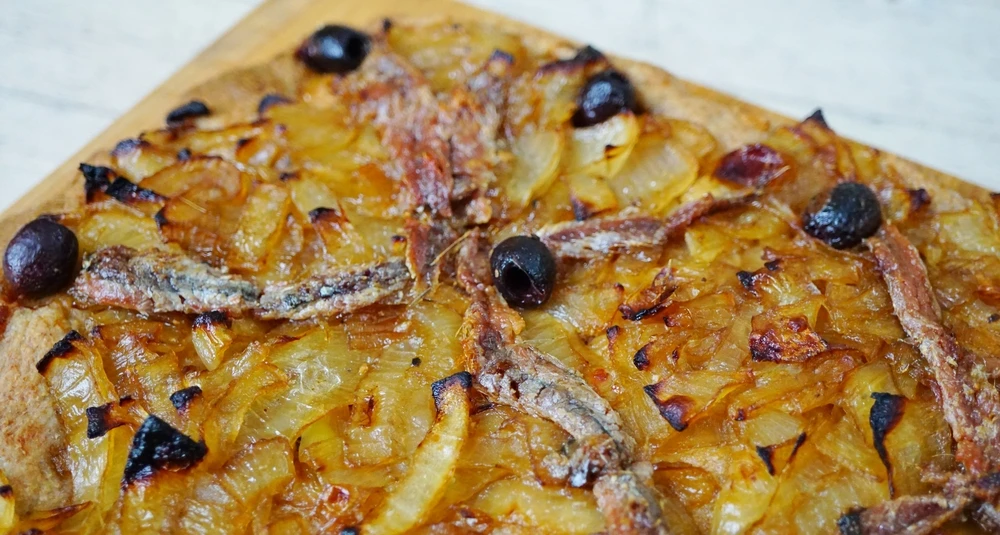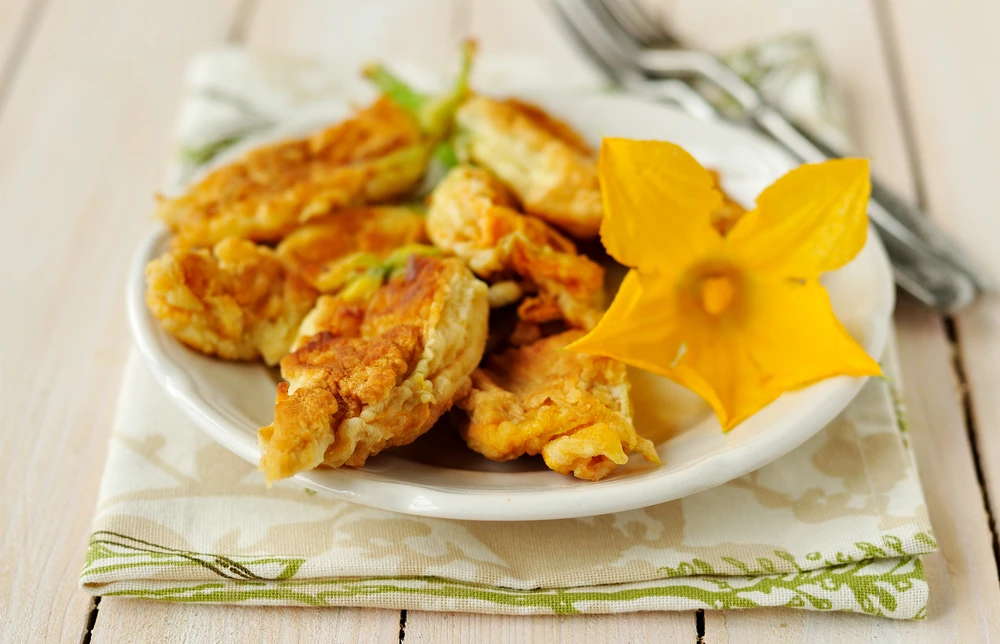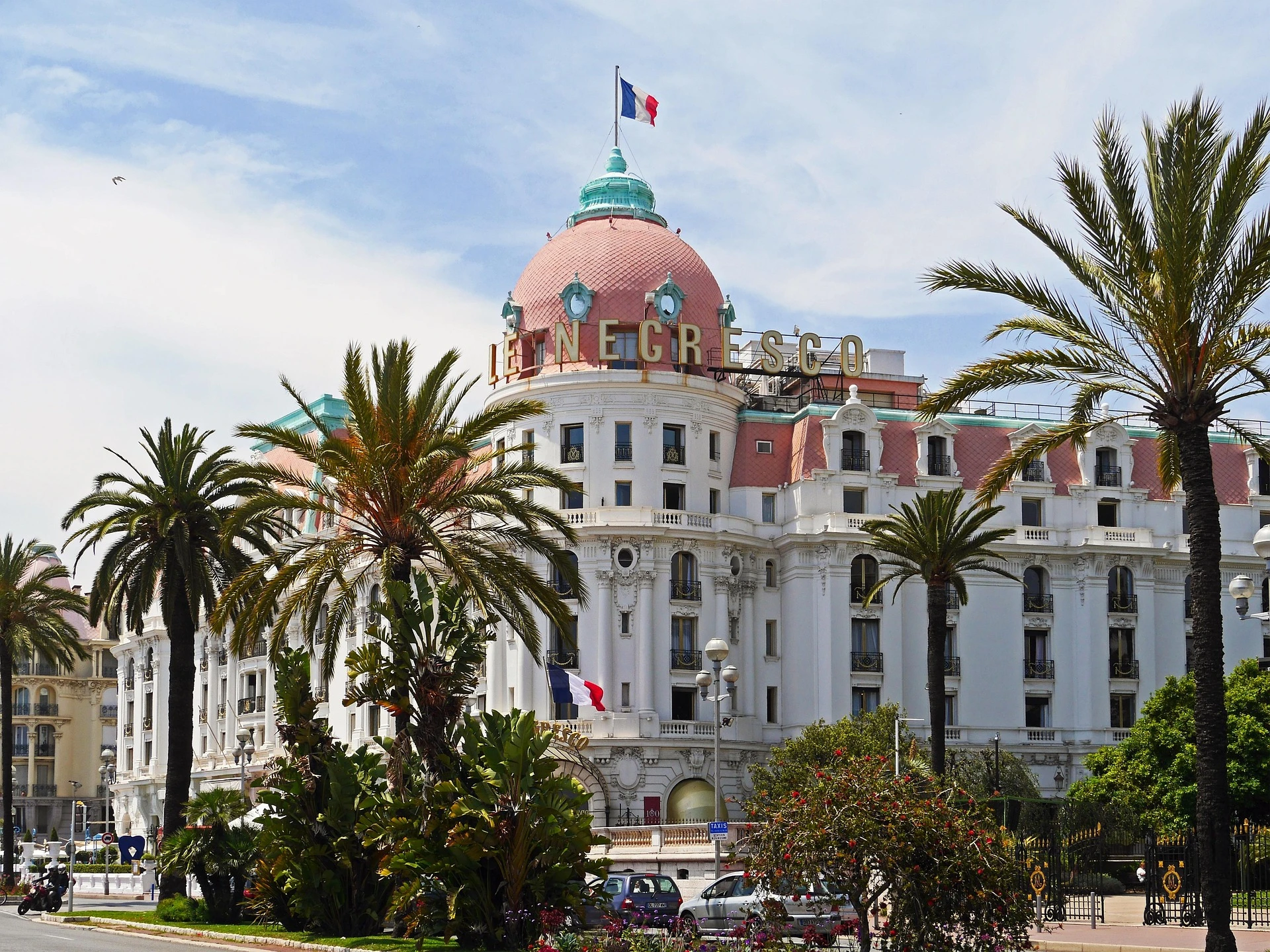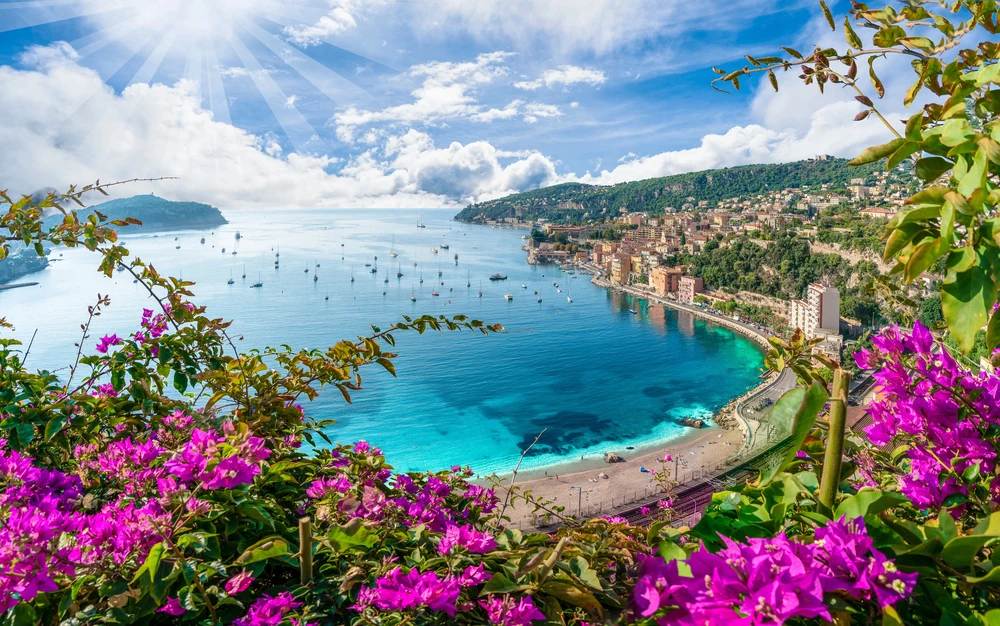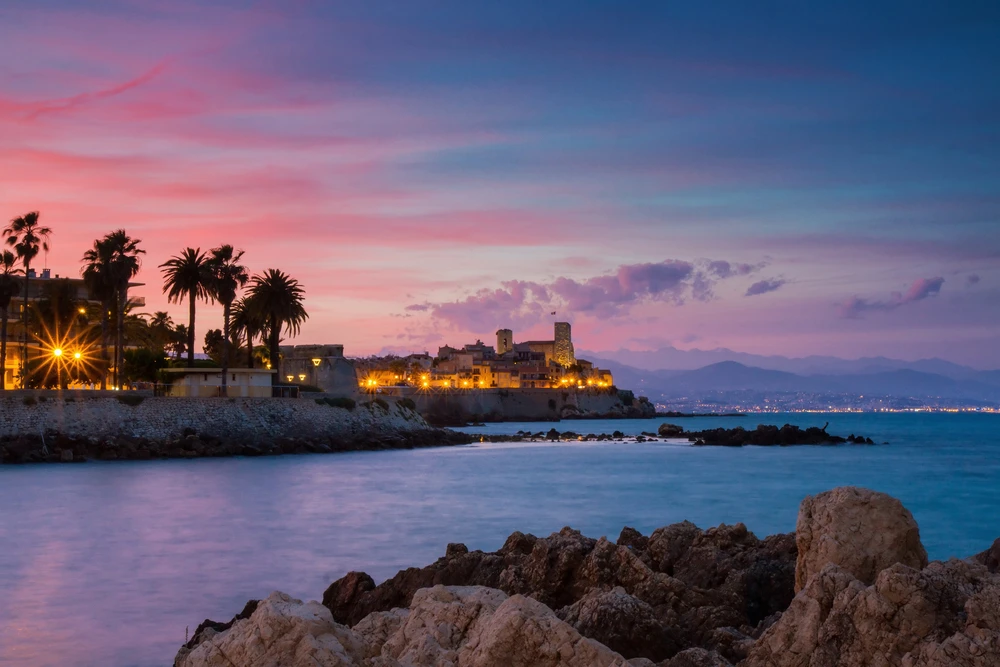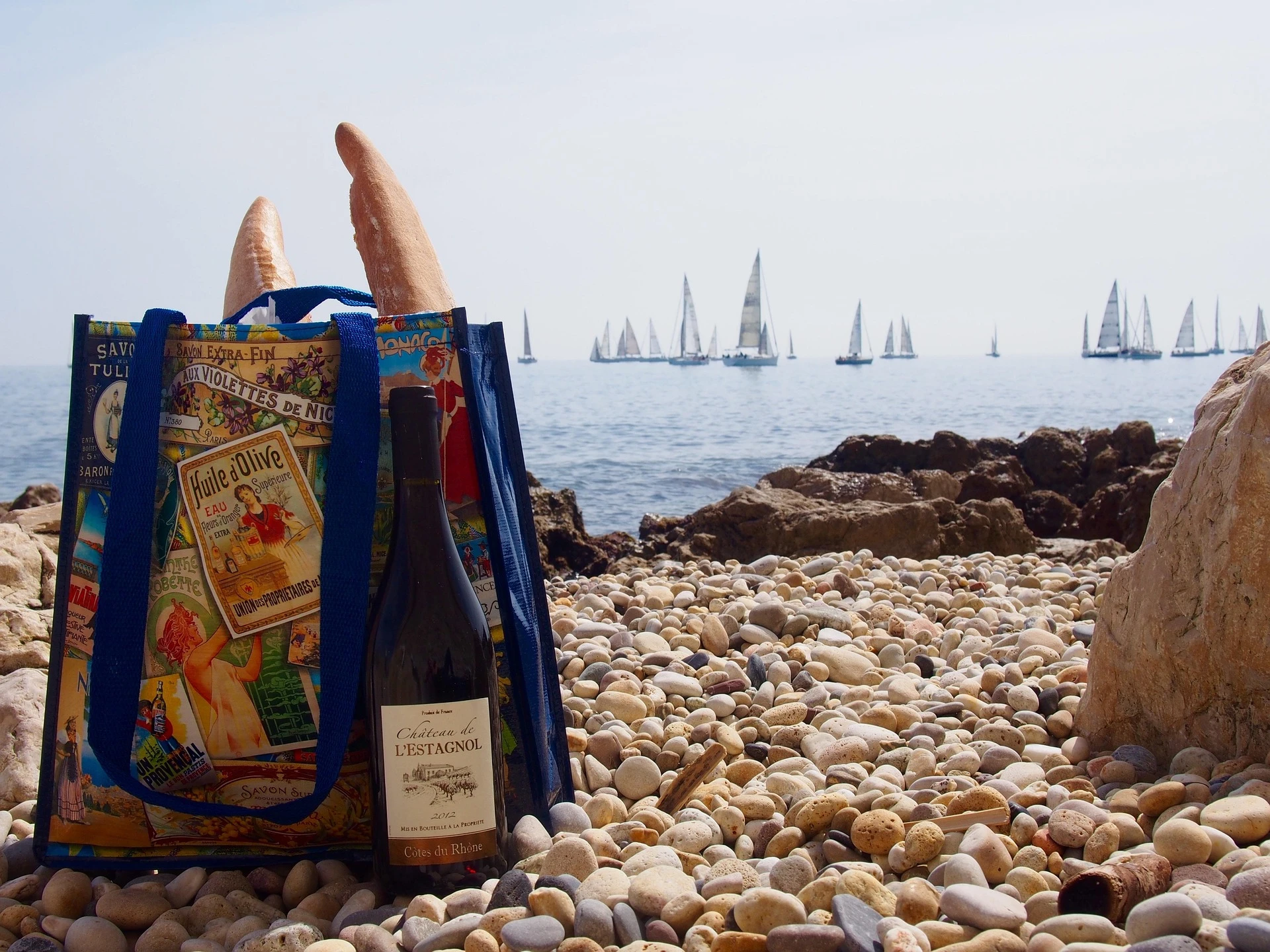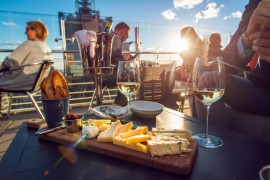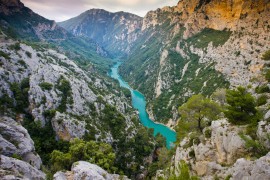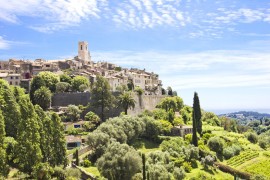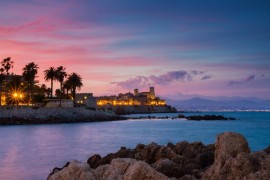Here is a summary of what you will discover:
In this article about Nice, I provide hour-by-hour itineraries to make the most of a day or a full weekend on the French Riviera. You will explore the Promenade des Anglais, Old Nice, the Cours Saleya market, panoramic viewpoints, and some secret local spots off the main tourist trail. I guide you to the best places to enjoy authentic Niçoise cuisine and experience the city at its true, gentle pace. You’ll also find practical advice — transport tips, walking times, timing suggestions — to ensure your visit flows smoothly, pleasantly, and memorably.
Nice between sea and mountains
Nice is one of the few cities in the world where you can admire the sea and the mountains in a single glance. Set on the edge of the Mediterranean, the city is bordered to the north by the Alps, which seem to plunge into the turquoise waters of the Baie des Anges. This unique geographical location offers a picture-postcard setting and an exceptional climate that has seduced travelers, artists and locals alike for centuries. France's fifth-largest city with almost 350,000 inhabitants, it is the capital of the Côte d'Azur. Renowned for its Promenade des Anglais, its beaches and the light of the Baie des Anges, it seduces as much for its Baroque Vieux-Nice as for its museums dedicated to Matisse and Chagall. The city is also known for its Carnaval, one of the most famous in the world, and for its art de vivre blending French culture and Italian influences. Between swimming, hiking in the hinterland, festivals and sunny gastronomy, Nice offers a unique setting where culture, sea and mountains meet.
The Baie des Anges, a mythical panorama
Nice and the Bay of Angels / photo by Aleksandar Todorovic/Shutterstock.com
To the south stretches the famous Baie des Anges, an immense 7-kilometer arc bathed in light. The people of Nice have always come here to stroll, swim or simply breathe in the sea air. The spectacle is different every hour of the day: brilliant blue in the morning, golden at sunset, sometimes silvery when the clouds roll in. This landscape has inspired painters like Raoul Dufy and Henri Matisse, who found unique colors to reproduce on their canvases.
Mountains, refuge and playground
Around thirty kilometers away, the Alps offer mid-mountain landscapes ideal for hiking. The Mercantour National Park, around 1h30 away, is a natural gem: high-altitude lakes, larch forests, stone villages and prehistoric engravings in the Vallée des Merveilles. In winter, you can even ski in resorts like Isola 2000 or Auron, accessible in less than two hours from Nice. Few cities in Europe allow you to take a dip in the sea in the morning and put on your skis in the afternoon.
A city between two cultures
Nice / photo par Reuben Teo/Shutterstock.com
This position between sea and mountains has shaped the history and culture of Nice. Here, the Italian influence remains very present, in recipes, in the Nice language and in village architecture. But the mountains, long a refuge and frontier, have also left their mark on local identity: the inhabitants found protection, pasture and wood here. Trade came from the sea, and both enemies and travelers arrived from the open sea. It is this dual identity that makes Nice a unique Mediterranean city, profoundly turned towards the world yet attached to its roots.
Top 5 things to see in Nice
1. The Promenade des Anglais, symbol of the Côte d'Azur
Nice la promenade des anglais/ photo by Elena Elisseeva/Shutterstock.com
It's impossible to talk about Nice without mentioning the Promenade des Anglais, the city's true emblem. Almost eight kilometers long, it runs along the Baie des Anges and attracts thousands of strollers every day. Created in the XIXᵉ century thanks to wealthy British winterers, it gave its name to this unique thoroughfare.
Sitting on the famous blue chairs, facing the sea, is a typically Nice experience. At dawn, joggers and cyclists pass by; during the day, families stroll along; and at dusk, the sight of the sun plunging into the Mediterranean is unforgettable. The promenade is also lined with legendary palaces such as the Negresco, a veritable icon of the Belle Époque. It's here that Nice asserts its vocation as an international seaside resort, attracting locals and travelers alike from all over the world.
2. Castle Hill and its panoramic view
Between Old Nice and the port, the colline du Château is a 20-hectare park where a fortress once stood. Destroyed in the XVIIIᵉ century, the castle has given way to belvederes offering the most beautiful views of the town.
From up there, you can take in the whole Baie des Anges, Vieux-Nice with its orange roofs and the port with its colorful facades. Access is by picturesque staircase or elevator, and the reward is immediate. Waterfalls, playgrounds, archaeological remains and shady paths make this an ideal place for families and photographers alike. It's one of Nice's best photo spots.
3. Old Nice and the Cours Saleya market
Le Cours Saleya in Nice and its market / photo by Rostislav Glinsky/Shutterstock.com
The Vieux-Nice is a labyrinth of narrow, cobbled, colorful streets. You'll discover an atmosphere that's both Italian and Provençal: painted facades, green shutters, lively little squares. The Baroque church of Sainte-Réparate dominates the Place Rossetti, illustrating the richness of the local religious heritage.
The Cours Saleya is the beating heart of this district. Its flower market, sun-drenched fruit stalls and scents of spices and aromatic herbs create a typically Mediterranean atmosphere. This is also the place to sample local specialties such as socca, pissaladière and zucchini flower fritters. In the evening, the terraces fill up and the neighborhood takes on a festive air. Old Nice is the city's living memory.
4. The port of Nice, between authenticity and modernity
Le port de Nice / photo par Cristina.A/Shutterstock.com
Located to the east of the city, the port Lympia is one of Nice's most authentic spots. Its quays, lined with ochre and red facades, are still home to traditional fishing boats, the famous brightly-colored "pointus".
The atmosphere here is quieter than on the Promenade des Anglais. Restaurants, bars and craftsmen welcome visitors, and yachts and unusual vessels can sometimes be admired here. The port is also a departure point for Corsica, but it remains above all a district of life in Nice, where tradition and modernity meet.
5. Museum of Modern and Contemporary Art (MAMAC)
For culture lovers, the MAMAC is a must-see. Located a stone's throw from Place Garibaldi, it is recognizable by its bold architecture, blending monumental cubes and aerial walkways.
Inside, you'll discover unique collections featuring Yves Klein, Niki de Saint Phalle, Andy Warhol and César. Temporary exhibitions also attract big names in contemporary art. The view over Nice and the surrounding hills from the museum's rooftops is spectacular. The nearby Promenade du Paillon offers a pleasant contrast between nature and modernity.
Nice: Facade of the Musée d'Art Moderne et D'Arc Contemporain (MAMAC) / photo by InnaFelker/Shutterstock.com
Nice gastronomy: Mediterranean flavours
Nicoise cuisine is the soul of the city.It tells a story of sunshine, the Mediterranean and traditions inherited from Italian and Provençal influences. It is distinguished by the simplicity of its ingredients, often from the vegetable garden or the sea, sublimated by olive oil, aromatic herbs and the generosity of the terroir.
Socca: the unmissable Niçoise galette
Une socca / photo par bonchan/Shutterstock.com
It's impossible to stay in Nice without trying socca, a thin wafer made from chickpea flour and olive oil, baked in a wood-fired oven. It's eaten piping hot, served on large plates and cut with a spatula. The people of Nice often eat it right off the paper, with a glass of local white wine. Socca is much more than a dish: it's a ritual. It's best found at the Cours Saleya market or in certain stalls in Vieux-Nice like Chez Pipo, an institution since 1923. Crunchy on the edges and soft in the center, it embodies the convivial spirit of Nice.
The Niçoise salad: a symbol known the world over
The salade niçoise is undoubtedly the most internationally famous specialty, but also the most distorted. The authentic version is an explosion of freshness: tomatoes, peppers, red onions, cébettes, févettes, hard-boiled eggs, black olives from Nice, tuna, sometimes anchovies, all drizzled with olive oil. In Nice, we never put potatoes or green beans: these additions come from Parisian adaptations. This salad originated in the XIXᵉ century, as a popular seasonal dish, prepared with whatever was available at the market. Today, it remains a dish of identity, defended with pride by the people of Nice.
Pissaladière: a tart with pickled onions
A pissaladière / photo by EQRoy/Shutterstock.com
Another classic, pissaladière is a pastry-based tart filled with onions preserved in olive oil, and decorated with anchovies and black olives. It takes its name from "pissalat", an anchovy paste that was once used as a condiment. It is eaten warm, cut into squares, as an aperitif or at the market. It's a dish that illustrates the proximity between land and sea: the onions come from the surrounding hills, the anchovies from the Mediterranean. A concentrate of Mediterranean flavors in one bite.
Les petits farcis: the generosity of vegetables
The Nice region abounds in vegetables: zucchinis, eggplants, tomatoes, peppers. All lend themselves to the preparation of petits farcis, filled with a mixture of meat, breadcrumbs, garlic and herbs. It's a family dish, often prepared in large quantities to feed a table. Every family has its own recipe, sometimes handed down from generation to generation. These are dishes with a whiff of summer, large gatherings and the Mediterranean art of living.
Zucchini flower fritters: a taste of summer
Fragile and delicate, zucchini flowers are transformed into light fritters after passing through a batter. Golden and crispy, they can be enjoyed at a market or in the restaurants of Old Nice.
An ephemeral dish, it symbolizes the summer season, when zucchini blossoms in profusion in the vegetable gardens of the hinterland. A refined yet popular dish.
Zucchini flower beignets/ photo by Tatiana Vorona/Shutterstock.com
Other Nice specialities to discover
-
Pan bagnat, a round sandwich filled with the same ingredients as Niçoise salad, soaked in olive oil.
-
Chard pie, sweet, surprising for those discovering this unique pastry, made with chard, pine nuts and raisins.
-
La daube niçoise, a beef stew simmered in red wine, herbs and vegetables, a heritage of Provencal and Italian cuisine.
-
Nicoise ravioli, stuffed with meat or chard, often topped with fragrant tomato sauce.
The cuisine of Nice reflects the city's geographical location. Ligurian, Provençal and Piedmontese influences are all present. Seafood mingles with local vegetables, all enhanced by olive oil from the Vallée des Paillons or Comté de Nice. This gastronomy is also an invitation to share: each dish is designed to be enjoyed together, around a convivial table.
To taste Niçoise cuisine is to understand the soul of the city. It's simple, generous and sunny, just like the people of Niçoise.
Nice between sea and mountains: landscapes and activities
Nice is a city of a thousand faces, capable of appealing as much to idlers as to those passionate about hiking or cultural discovery. Here, the Mediterranean combines with the Alpine relief to offer an incomparable playground.
Le Negresco on "the prom" / Photo chosen by monsieurdefrance.com: by Erich Westendarp from Pixabay
Nice's beaches and the Mediterranean
Nice is famous for its pebble beaches, which stretch along the Promenade des Anglais. They are both public and private, with different atmospheres. Some offer sunbeds and restaurants, others retain a simpler charm.
The Baie des Anges is also ideal for water sports: paddle, sailing, scuba diving. The crystal-clear waters allow you to discover an amazing array of marine life just a few meters from the shore. In summer, the people of Nice love to come together for family swims, but also in the evening, to enjoy the coolness at the water's edge.
par Ben Kerckx de Pixabay
Hills and panoramas
Behind the waterfront, the hills offer spectacular vistas. The Mont Boron, accessible by a short hike, allows you to admire the town and even catch a glimpse of the Italian border. The fort du Mont-Alban, built in the XVIᵉ century, is a military relic overlooking the Mediterranean. From its ramparts, you can embrace a landscape stretching from Monaco to the Estérel massif. These panoramas are among the finest on the Côte d'Azur.
Sports and nature activities
Nice is not just a seaside town, it's also a sporting destination. The sentier du littoral allows you to walk from Nice to Villefranche-sur-Mer, with spectacular panoramas over the Mediterranean. Cycling enthusiasts will find renowned routes, often used by the Tour de France. In winter, the Southern Alps are just 90 minutes away: you can go from warm sand to snowy slopes in a day. The resorts of Isola 2000, Auron or Valberg welcome ski and snowshoe enthusiasts. This proximity makes Nice unique in Europe.
Around Nice
La baie de Villefranche / Photo chosen by Monsieur de France: depositphotos
Half an hour's drive away, we discover another face of the region. Saint-Paul-de-Vence, an artistic mecca, seduces with its galleries and medieval alleyways. Eze, perched on a rocky spur, marvels at its exotic garden suspended above the Mediterranean. Also worth seeing: Saint Jean Cap Ferrat, Villefranche sur Mer... The villages of the Niçois hinterland offer a taste of Provence, with their fountains, shady squares and colorful markets. It's also a region of olive growing and viticulture, producing top-quality olive oil and Bellet wines, among the oldest vineyards in France.
The view of Antibes at night / Photo chosen by monsieurdefrance.com : Circumnavi via dépositphotos
Events and festivals in Nice
Beyond its landscapes, Nice also vibrates to the rhythm of its events. The most famous is undoubtedly the Carnaval de Nice, one of the biggest in the world, with its colorful floats and flower battles that light up the Promenade des Anglais in February.
Not far away, in Menton, the fête du Citron completes this festive program with its giant citrus sculptures. These events attract thousands of visitors every year, and remind us that the Côte d'Azur is a place of joy and creativity.
Nice: access and routes
Why not have a picnic on one of Nice's pebble beaches / Photo chosen by Monsieur de France: Pixabay
Nice is served by the aéroport Nice Côte d'Azur, located at 1601 Route de l'Aéroport, 06200 Nice. France's second-largest airport, it offers numerous national and international connections. A tramway (line 2) links the airport directly to the city center in around twenty minutes.
Getting around is made easy by the city's network of trams and buses. Three streetcar lines cross the city, complemented by dozens of bus routes serving the hinterland and coastline.
Distances and travel times from Nice :
-
Nice - Paris : 930 km, approx. 9h30 by car / 5h30 by TGV direct.
-
Nice - Marseille: 200 km, approx. 2h15 by car / 2h30 by train.
-
Nice - Monaco : 20 km, approx. 30 min by car / 25 min by TER.
FAQ – Nice
1. Is Nice a safe city for visitors?
Yes, Nice is a safe city overall. As everywhere else, it's advisable to remain vigilant in less frequented areas at night, and to keep an eye on your belongings in very touristy places.
2. When is the best time to visit Nice?
Spring (April to June) and autumn (September-October) are ideal: pleasant weather and moderate crowds. Summer is warm and festive, while winter remains mild with the famous Nice Carnival.
3. How many days does it take to discover Nice?
Two to three days are enough to see the major must-sees. But a stay of four or five days allows you to enjoy museums, beaches and explore the hinterland.
4. How do I get from the airport to downtown Nice?
The tramway (line 2) links Nice Côte d'Azur airport directly to the city center in around 20 minutes. Buses, cabs and shuttles complete the offer.
5. How convenient is public transport in Nice?
Yes. Streetcars and buses serve the city and neighboring towns very well. For short distances, Nice is also very easy to discover on foot.
6. What's there to see and do in Nice?
The Promenade des Anglais, Old Nice and its Cours Saleya market, Chateau Hill, Port Lympia and MAMAC. The Matisse and Chagall museums are also worth a visit, as are excursions to Eze, Villefranche or Saint-Paul-de-Vence.
7. Are there beaches in Nice?
Yes, all along the Promenade des Anglais. Some are public, others private, with deckchairs and restaurants. These are pebble beaches: we advise you to bring appropriate footwear for greater comfort.

